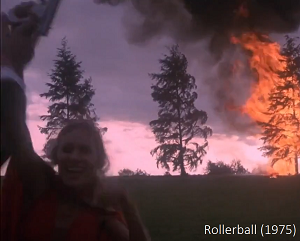
If there’s one movie that serves as a fundamental text for understanding Rollerwave, both as an aesthetic and a way of life, it’s Rollerball, the film from which Rollerwave derives its name. I was first introduced to this movie because of the aesthetic, and at this point I’ve watched it at least 5 times. There is no other way to describe the movie- every frame carries an aesthetic that is entirely Rollerwave, front to back.
The film follows Jonathan, a participant in a brutal yet insanely popular sport called Rollerball, as he leads his Houston-based team to victory while simultaneously unraveling deep-seated government conspiracies which infest the society of the bizarre 21st century in which he resides. Along the way, he must grapple with identity, love, and the danger of the sport itself.
Make no mistake: Rollerball is a strange film which to the modern viewer appears quaint and confusing, yet when it was released it was very sincere in its message. It is an extremely generic film, full of cliches which even for its time were old, yet which handles every shot which such tact, and every set with such authenticity, that it should be respected at the very least as a groundbreaking work of science fiction, from a visual standpoint.
The society of Rollerball is one in which war does not exist, where conflict is at an all-time minimum and boredom is the result, and as such society becomes languid and hedonistic. This sense of growing unease is expressed not only via society’s preoccupation with the violence of Rollerball, but through vividly shot sequences such as the one below, wherein a group of drug-fueled partiers take to the fields to shoot beautiful pine trees with a fiery gun of death, grinning and laughing ecstatically all the while. It is a subtle display of societal decay- entirely absent in modern dystopian films where murder is legal or where the world has collapsed entirely into an unrecognizable soup- yet it is much, much more effective in portraying a world that is fundamentally broken.
Rollerwave owes a debt of gratitude to Rollerball, as several components of the film- such as the font it uses in its title, Westminster- have become staples of the aesthetic. The 2017 album “To Every Man,” acknowledged by Rollerwave aficionados as a staple of the genre, notably samples Andre Previn’s “Executive Party Dance” on the track “ F+a+s+t+F+o+r+w+a+r+d”. It’s an eerie tune, disquieting with how velvet smooth it is. Like the film, it invokes a sense of indescribable malcontent. Something isn’t quite right.
Rollerball is a fantastic film and a must-watch for anyone interested in Rollerwave as a concept. Anytime someone asks me what Rollerwave looks like, I think I’ll point them in the direction of Rollerball. It truly has to be seen to be believed.